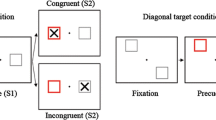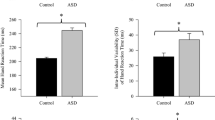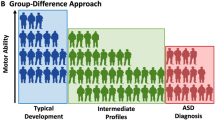Abstract
Sensorimotor abnormalities are common in individuals with autism spectrum disorder (ASD); however, the processes underlying these deficits remain unclear. This study examined force production with and without visual feedback to determine if individuals with ASD can utilize internal representations to guide sustained force. Individuals with ASD showed a faster rate of force decay in the absence of visual feedback. Comparison of force output and tests of social and verbal abilities demonstrated a link between motor memory impairment and social and verbal deficits in individuals with ASD. This finding suggests that deficits in storage or retrieval of motor memories contribute to sensorimotor deficits and implicates frontoparietal networks involved in short-term consolidation of action dynamics used to optimize ongoing motor output.




Similar content being viewed by others
References
Annett, M. (1970). A classification of hand preference by association analysis. British Journal of Psychology, 61(3), 303–321.
Association, A. P. (1994). American Psychiatric Association: Diagnostic and statistical manual of mental disorders (4th ed.). Arlington, VA: Association, A. P.
Baddeley, A. (1986). Modularity, mass-action and memory. Quarterly Journal of Experimental Psychology A, 38(4), 527–533.
Berument, S. K., Rutter, M., Lord, C., Pickles, A., & Bailey, A. (1999). Autism screening questionnaire: diagnostic validity. British Journal of Psychiatry, 175, 444–451.
Diedrichsen, J., Hashambhoy, Y., Rane, T., & Shadmehr, R. (2005a). Neural correlates of reach errors. Journal of Neuroscience, 25(43), 9919–9931. doi:10.1523/JNEUROSCI.1874-05.2005.
Diedrichsen, J., Verstynen, T., Lehman, S. L., & Ivry, R. B. (2005b). Cerebellar involvement in anticipating the consequences of self-produced actions during bimanual movements. Journal of Neurophysiology, 93(2), 801–812. doi:10.1152/jn.00662.2004.
Doumas, M., McKenna, R., & Murphy, B. (2016). Postural control deficits in autism spectrum disorder: The role of sensory integration. Journal of Autism and Developmental Disorders, 46(3), 853–861. doi:10.1007/s10803-015-2621-4.
Dziuk, M. A., Gidley Larson, J. C., Apostu, A., Mahone, E. M., Denckla, M. B., & Mostofsky, S. H. (2007). Dyspraxia in autism: Association with motor, social, and communicative deficits. Developmental Medicine and Child Neurology, 49(10), 734–739. doi:10.1111/j.1469-8749.2007.00734.x.
Elison, J. T., Wolff, J. J., Reznick, J. S., Botteron, K. N., Estes, A. M., Gu, H., et al. (2014). Repetitive behavior in 12-month-olds later classified with autism spectrum disorder. Journal of the American Academy of Child and Adolescent Psychiatry, 53(11), 1216–1224. doi:10.1016/j.jaac.2014.08.004.
Fournier, K. A., Hass, C. J., Naik, S. K., Lodha, N., & Cauraugh, J. H. (2010). Motor coordination in autism spectrum disorders: A synthesis and meta-analysis. Journal of Autism and Developmental Disorders, 40(10), 1227–1240. doi:10.1007/s10803-010-0981-3.
Fuentes, C. T., Mostofsky, S. H., & Bastian, A. J. (2009). Children with autism show specific handwriting impairments. Neurology, 73(19), 1532–1537. doi:10.1212/WNL.0b013e3181c0d48c.
Glazebrook, C., Gonzalez, D., Hansen, S., & Elliott, D. (2009). The role of vision for online control of manual aiming movements in persons with autism spectrum disorders. Autism, 13(4), 411–433. doi:10.1177/1362361309105659.
Gordon, A. M., Westling, G., Cole, K. J., & Johansson, R. S. (1993). Memory representations underlying motor commands used during manipulation of common and novel objects. Journal of Neurophysiology, 69(6), 1789–1796.
Grafton, S. T., Schmitt, P., Van Horn, J., & Diedrichsen, J. (2008). Neural substrates of visuomotor learning based on improved feedback control and prediction. Neuroimage, 39(3), 1383–1395. doi:10.1016/j.neuroimage.2007.09.062.
Graham, S. A., Abbott, A. E., Nair, A., Lincoln, A. J., Muller, R. A., & Goble, D. J. (2015). The influence of task difficulty and participant age on balance control in ASD. Journal of Autism and Developmental Disorders, 45(5), 1419–1427. doi:10.1007/s10803-014-2303-7.
Green, D., Baird, G., Barnett, A. L., Henderson, L., Huber, J., & Henderson, S. E. (2002). The severity and nature of motor impairment in Asperger’s syndrome: A comparison with specific developmental disorder of motor function. Journal of Child Psychology and Psychiatry, 43(5), 655–668.
Haswell, C. C., Izawa, J., Dowell, L. R., Mostofsky, S. H., & Shadmehr, R. (2009). Representation of internal models of action in the autistic brain. Nature Neuroscience, 12(8), 970–972. doi:10.1038/nn.2356.
Herbert, M. R., Ziegler, D. A., Deutsch, C. K., O’Brien, L. M., Lange, N., Bakardjiev, A., & Caviness, V. S, Jr. (2003). Dissociations of cerebral cortex, subcortical and cerebral white matter volumes in autistic boys. Brain, 126(Pt 5), 1182–1192.
Izawa, J., Pekny, S. E., Marko, M. K., Haswell, C. C., Shadmehr, R., & Mostofsky, S. H. (2012). Motor learning relies on integrated sensory inputs in ADHD, but over-selectively on proprioception in autism spectrum conditions. Autism Research, 5(2), 124–136. doi:10.1002/aur.1222.
Johansson, R. S., & Cole, K. J. (1992). Sensory-motor coordination during grasping and manipulative actions. Current Opinion in Neurobiology, 2(6), 815–823.
Johansson, R. S., & Westling, G. (1984). Roles of glabrous skin receptors and sensorimotor memory in automatic control of precision grip when lifting rougher or more slippery objects. Experimental Brain Research, 56(3), 550–564.
Johnson, B. P., Rinehart, N. J., Papadopoulos, N., Tonge, B., Millist, L., White, O., & Fielding, J. (2012). A closer look at visually guided saccades in autism and Asperger’s disorder. Frontiers in Integrative Neuroscience, 6, 99. doi:10.3389/fnint.2012.00099.
LeBarton, E. S., & Iverson, J. M. (2013). Fine motor skill predicts expressive language in infant siblings of children with autism. Developmental Science, 16(6), 815–827. doi:10.1111/desc.12069.
Leonard, H. C., Bedford, R., Charman, T., Elsabbagh, M., Johnson, M. H., Hill, E. L., et al. (2014). Motor development in children at risk of autism: A follow-up study of infant siblings. Autism, 18(3), 281–291. doi:10.1177/1362361312470037.
Lord, C., Risi, S., Lambrecht, L., Cook, E. H, Jr, Leventhal, B. L., DiLavore, P. C., & Rutter, M. (2000). The autism diagnostic observation schedule-generic: A standard measure of social and communication deficits associated with the spectrum of autism. Journal of Autism and Developmental Disorders, 30(3), 205–223.
Lord, C., Rutter, M., & Le Couteur, A. (1994). Autism diagnostic interview-revised: A revised version of a diagnostic interview for caregivers of individuals with possible pervasive developmental disorders. Journal of Autism and Developmental Disorders, 24(5), 659–685.
Luna, B., Doll, S. K., Hegedus, S. J., Minshew, N. J., & Sweeney, J. A. (2007). Maturation of executive function in autism. Biological Psychiatry, 61(4), 474–481. doi:10.1016/j.biopsych.2006.02.030.
Luna, B., Minshew, N. J., Garver, K. E., Lazar, N. A., Thulborn, K. R., Eddy, W. F., & Sweeney, J. A. (2002). Neocortical system abnormalities in autism: An fMRI study of spatial working memory. Neurology, 59(6), 834–840.
Mari, M., Castiello, U., Marks, D., Marraffa, C., & Prior, M. (2003). The reach-to-grasp movement in children with autism spectrum disorder. Philosophical Transactions of the Royal Society of London B: Biological Sciences, 358(1430), 393–403. doi:10.1098/rstb.2002.1205.
Marsden, C. D., Rothwell, J. C., & Day, B. L. (1983). Long-latency automatic responses to muscle stretch in man: Origin and function. Advances in Neurology, 39, 509–539.
Massaro, D. W., & Loftus, G. R. (1996). Sensory and perceptual storage. In E. L. Bjork & R. A. Bjork (Eds.), Memory (pp. 68–96). San Diego, CA: Academic Press.
Minshew, N. J., Luna, B., & Sweeney, J. A. (1999). Oculomotor evidence for neocortical systems but not cerebellar dysfunction in autism. Neurology, 52(5), 917–922.
Minshew, N. J., Sung, K., Jones, B. L., & Furman, J. M. (2004). Underdevelopment of the postural control system in autism. Neurology, 63(11), 2056–2061.
Molloy, C. A., Dietrich, K. N., & Bhattacharya, A. (2003). Postural stability in children with autism spectrum disorder. Journal of Autism and Developmental Disorders, 33(6), 643–652.
Mosconi, M. W., Kay, M., D'Cruz, A. M., Guter, S., Kapur, K., Macmillan, C., et al. (2010). Neurobehavioral abnormalities in first-degree relatives of individuals with autism. Archives of General Psychiatry, 67(8), 830–840. doi:10.1001/archgenpsychiatry.2010.87.
Mosconi, M. W., Mohanty, S., Greene, R. K., Cook, E. H., Vaillancourt, D. E., & Sweeney, J. A. (2015). feedforward and feedback motor control abnormalities implicate cerebellar dysfunctions in autism spectrum disorder. Journal of Neuroscience, 35(5), 2015–2025. doi:10.1523/Jneurosci.2731-14.2015.
Mostofsky, S. H., & Ewen, J. B. (2011). Altered connectivity and action model formation in autism is autism. Neuroscientist, 17(4), 437–448. doi:10.1177/1073858410392381.
Nebel, M. B., Eloyan, A., Nettles, C. A., Sweeney, K. L., Ament, K., Ward, R. E., & Mostofsky, S. H. (2016). Intrinsic visual-motor synchrony correlates with social deficits in autism. Biological Psychiatry, 79(8), 633–641. doi:10.1016/j.biopsych.2015.08.029.
Nickel, L. R., Thatcher, A. R., Keller, F., Wozniak, R. H., & Iverson, J. M. (2013). Posture development in infants at heightened vs. low risk for autism spectrum disorders. Infancy, 18(5), 639–661. doi:10.1111/infa.12025.
Oldfield, R. C. (1971). The assessment and analysis of handedness: the Edinburgh inventory. Neuropsychologia, 9(1), 97–113.
Ozonoff, S., Young, G. S., Belding, A., Hill, M., Hill, A., Hutman, T., et al. (2014). The broader autism phenotype in infancy: When does it emerge? Journal of the American Academy of Child and Adolescent Psychiatry, 53(4), 398–407. e2. doi:10.1016/j.jaac.2013.12.020.
Papadopoulos, N., McGinley, J., Tonge, B., Bradshaw, J., Saunders, K., Murphy, A., & Rinehart, N. (2012). Motor proficiency and emotional/behavioural disturbance in autism and Asperger’s disorder: Another piece of the neurological puzzle? Autism, 16(6), 627–640. doi:10.1177/1362361311418692.
Reilly, J. L., Lencer, R., Bishop, J. R., Keedy, S., & Sweeney, J. A. (2008). Pharmacological treatment effects on eye movement control. Brain and Cognition, 68(3), 415–435. doi:10.1016/j.bandc.2008.08.026.
Rosenhall, U., Johansson, E., & Gillberg, C. (1988). Oculomotor findings in autistic children. Journal of Laryngology and Otology, 102(5), 435–439.
Schmitt, L. M., Cook, E. H., Sweeney, J. A., & Mosconi, M. W. (2014). Saccadic eye movement abnormalities in autism spectrum disorder indicate dysfunctions in cerebellum and brainstem. Mol Autism, 5(1), 47. doi:10.1186/2040-2392-5-47.
Sweeney, J. A., Mintun, M. A., Kwee, S., Wiseman, M. B., Brown, D. L., Rosenberg, D. R., & Carl, J. R. (1996). Positron emission tomography study of voluntary saccadic eye movements and spatial working memory. Journal of Neurophysiology, 75(1), 454–468.
Takagi, M., Zee, D. S., & Tamargo, R. J. (1998). Effects of lesions of the oculomotor vermis on eye movements in primate: saccades. Journal of Neurophysiology, 80(4), 1911–1931.
Takagi, M., Zee, D. S., & Tamargo, R. J. (2000). Effects of lesions of the oculomotor cerebellar vermis on eye movements in primate: Smooth pursuit. Journal of Neurophysiology, 83(4), 2047–2062.
Takarae, Y., Minshew, N. J., Luna, B., & Sweeney, J. A. (2007). Atypical involvement of frontostriatal systems during sensorimotor control in autism. Psychiatry Research, 156(2), 117–127. doi:10.1016/j.pscychresns.2007.03.008.
Travers, B. G., Powell, P. S., Klinger, L. G., & Klinger, M. R. (2013). Motor difficulties in autism spectrum disorder: Linking symptom severity and postural stability. Journal of Autism and Developmental Disorders, 43(7), 1568–1583. doi:10.1007/s10803-012-1702-x.
Tseng, Y. W., Diedrichsen, J., Krakauer, J. W., Shadmehr, R., & Bastian, A. J. (2007). Sensory prediction errors drive cerebellum-dependent adaptation of reaching. Journal of Neurophysiology, 98(1), 54–62. doi:10.1152/jn.00266.2007.
Vaillancourt, D. E., Slifkin, A. B., & Newell, K. M. (2001). Visual control of isometric force in Parkinson's disease. Neuropsychologia, 39(13), 1410–1418.
Vaillancourt, D. E., Thulborn, K. R., & Corcos, D. M. (2003). Neural basis for the processes that underlie visually guided and internally guided force control in humans. Journal of Neurophysiology, 90(5), 3330–3340. doi:10.1152/jn.00394.2003.
Wang, Z., Magnon, G. C., White, S. P., Greene, R. K., Vaillancourt, D. E., & Mosconi, M. W. (2015). Individuals with autism spectrum disorder show abnormalities during initial and subsequent phases of precision gripping. Journal of Neurophysiology, 113(7), 1989–2001. doi:10.1152/jn.00661.2014.
Wechsler, D. (1999). Wechsler abbreviated scale of intelligence. San Antonio, TX: Psychological Corporation.
Acknowledgments
This study was supported by NIMH 092696 and 67631, NICHD Autism Center of Excellence 055751, NINDS 082008, NINDS 078874, NCATS TR000126, and Autism Speaks 4853.
Authors’ Contributions
KN carried out data analyses, data interpretation, and drafting the manuscript. SM helped with statistical analyses, interpreting the data, and drafting the manuscript. LS helped with data collection, data analysis, and interpretation. ZW helped with data analysis and interpretation. JS helped with data analysis and manuscript preparation. MM provided input on conception and design of the study, assisted in data analysis and interpretation, and helped revise the manuscript for important intellectual content. All authors read and approved the final manuscript.
Author information
Authors and Affiliations
Corresponding author
Ethics declarations
Conflict of interest
The authors declare that they have no conflict of interest.
Ethical Approval
All procedures performed in studies involving human participants were in accordance with the ethical standards of the institutional and/or national research committee and with the 1964 Helsinki declaration and its later amendments or comparable ethical standards.
Informed Consent
Informed consent was obtained from all individual participants included in the study.
Rights and permissions
About this article
Cite this article
Neely, K.A., Mohanty, S., Schmitt, L.M. et al. Motor Memory Deficits Contribute to Motor Impairments in Autism Spectrum Disorder. J Autism Dev Disord 49, 2675–2684 (2019). https://doi.org/10.1007/s10803-016-2806-5
Published:
Issue Date:
DOI: https://doi.org/10.1007/s10803-016-2806-5




